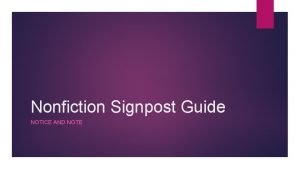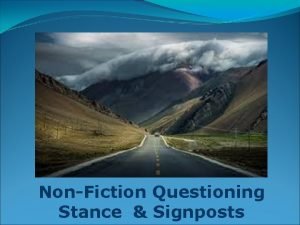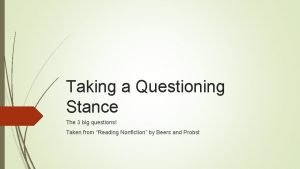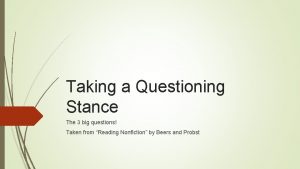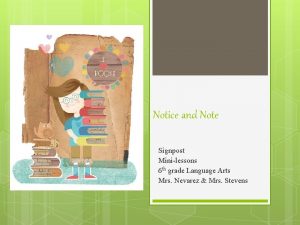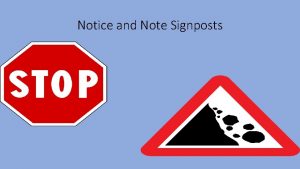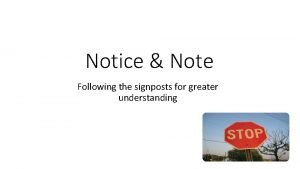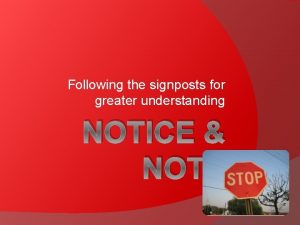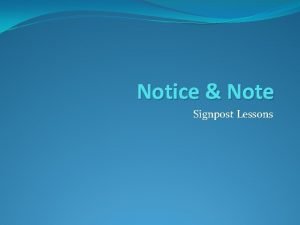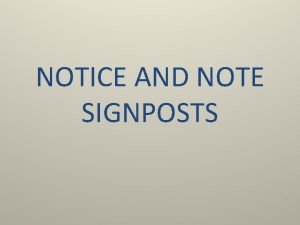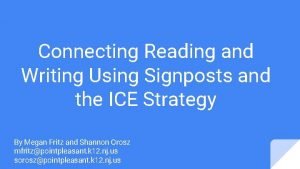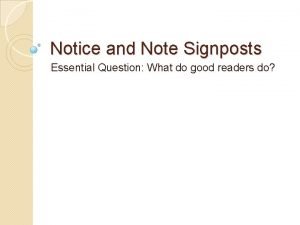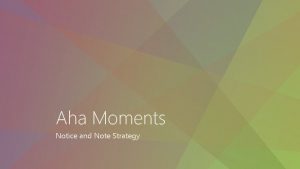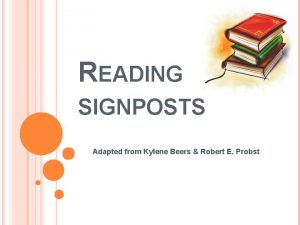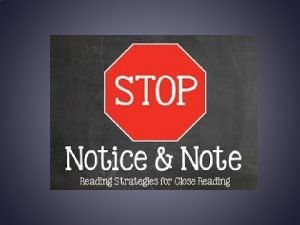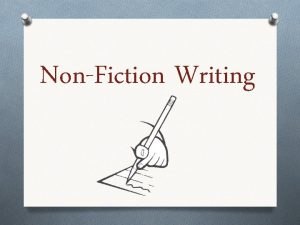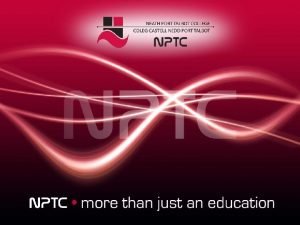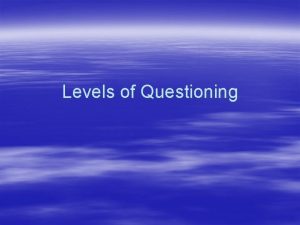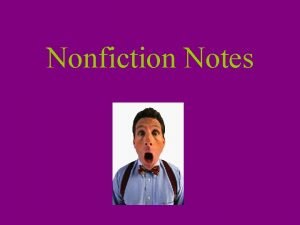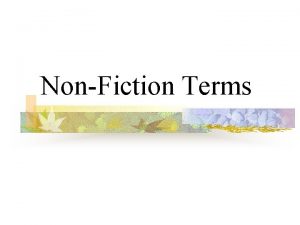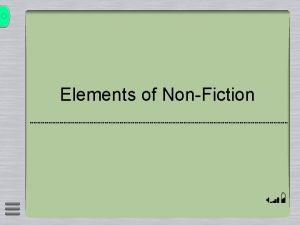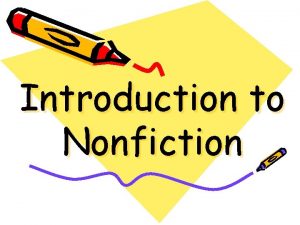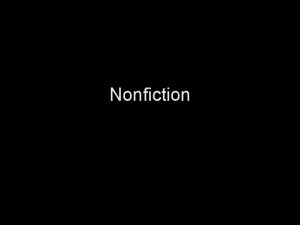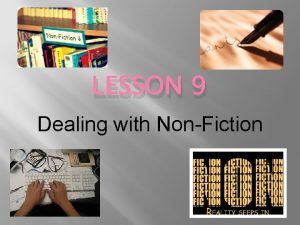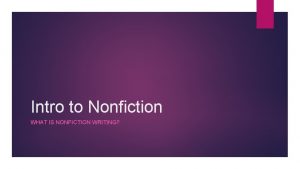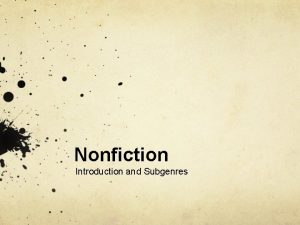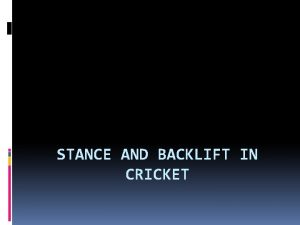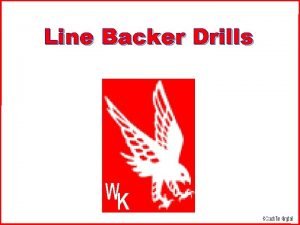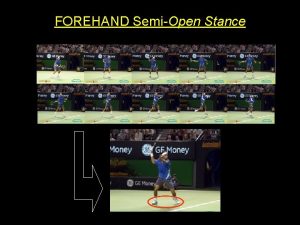NonFiction Questioning Stance Signposts The Questioning Stance Nonfiction



















- Slides: 19

Non-Fiction Questioning Stance & Signposts

The Questioning Stance Nonfiction should come with cautionary note that reminds us that getting lost in the text might be dangerous. The reader needs to remember that a work of nonfiction will try to take a position about the world and needs to take those positions with a grain of skepticism. They may be perfectly true. They may be slanted or biased. Or, they may be flat out lies. This skeptical stance implies 3 questions: What surprised me? What did the author think I already knew? What changed, challenged or confirmed what I already knew?

Big Question #1 – What surprised me? Four categories of surprise: 1. New information v I didn’t know that? 2. Suspicious information v Really? Is that true? 3. Clarifying information v Oh! Now I get it 4. A different perpective v I hadn’t thought of it that way.

Big Question #1 – What surprised me? Possible response starters are: ● I was shocked about… ● I was surprised when… ● I never thought… ● I could not believe… ● Really? Big Question #1 - What Surprised Me?

Notice and Note Nonfiction – Big Questions ●Big Question 1 - What Surprised Me?

Big Question #2 What did the author think I already knew? When students look at the text with the above question in mind instead of giving up, then they almost always identify what it is they need to do to clear up the misunderstanding. They find solutions to their “I don’t get it”.

Big Question #2 What did the author think I already knew? The four types of problems identified: 1. The author thought I’d know what this word means. (vocabulary). 2. The author thought I could picture this. (visualizing). 3. The author thought I’d know something about this. (making connections/prior knowledge) 4. The author thought I’d get how that happens. (Sequencing or causal relationships)

Big Question #2 What did the author think I already knew? Response Starters ●I did not know… ●I was confused by… ●The author assumed… ●The author thought I knew… Big Question #2 - What did the author think I already know?

Big Question #3 What challenged, changed or confirmed what I knew? This question doesn’t emphasize memorizing data from a text. It doesn’t tell a student that he is right or wrong. It does tell the student that changing your mind is respectable and should happen occasionally. It respects the student’s responses by asking how the text shaped their thinking. Equips them with observations that should help them talk about it.

Big Question #3 What challenged, changed or confirmed what I knew? Three points: 1. We read nonfiction to learn something. 2. Learning is more than memorizing: it involves changing the way we think about an issue or idea. 3. We can change several ways. We can: a. b. c. Confirm what we already thought Modify our thinking Change our minds completely

Big Question #3 What challenged, changed or confirmed what I knew? Response starters: ●At first I thought, but… ●I had to rethink. . . ●My understanding changed when… ●I was right/wrong about…. Big Question #3 - What challenged, changed or confirmed what I knew?

Learning Target: Define, identify and analyze signposts within nonfiction texts. Success Criteria: I will take clear and accurate notes on the different signposts and utilize these notes to analyze practice shorts. This practice will aid me in analyzing our longer Investigative Reports.

What is a Signpost? ● When you’re driving a car, you notice the signs and respond accordingly. ● It’s the same with reading: common patterns, or “signs, ” become recognizable, and you should respond. ● In reading, we call these signs “signposts. ” These are places you recognize as important and where you need to stop, notice, and respond accordingly.

5 common signposts in non-fiction reading. Things to look for when reading a text ● Contrasts and Contradictions ● Word Gap ● Numbers and Stats ● Quoted Words ● Absolute/Extreme Language

Signpost #1: Contrasts & Contradictions DEFINITION: The author shows a difference between what you have known and what is happening in the text. QUESTION: What is the difference and why does it matter? SIGNAL WORDS: although, as opposed to, even though, however, instead, alternatively, nevertheless, on the other hand, otherwise, still, then again, unlike, yet, in contrast, in spite of this, nothing like ANSWERING THE QUESTION WILL HELP YOU FIND: main ideas; comparisons & contrasts; author’s purpose; inferences/ generalizations; causes & effects

Signpost #2: Word Gap DEFINITION: The author uses a word or phrase you don’t know. QUESTION: Do I know this word from someplace else? Is word technical talk for experts (jargon)? Can I find clues in the sentence or roots to help me understand this word? ANSWERING THE QUESTION WILL HELP YOU DECIDE IF: you need to look the word up; you need to keep reading for more information/ look for context clues for

Signpost #3: Numbers & Stats DEFINITION: The author uses specific numbers, word numbers, or amounts. QUESTION: Why did the author use those numbers or amounts? ANSWERING THE QUESTION WILL HELP YOU: come to a conclusion; make a comparison; see details; make inferences; find facts or recognize evidence

Signpost #4: Quoted Words DEFINITION: The author quotes a voice of authority, a personal perspective, or cites others words QUESTION: Why did the author quote or cite this person? ANSWERING THE QUESTION WILL TELL YOU: author’s point-of-view; author’s purpose; the difference between facts & opinions; how to make a generalizations

Signpost #5: Absolute/ Extreme Language DEFINITION: The author uses language that leaves no doubt, exaggerates, or pushes the limit QUESTION: Why did the author say it like that? SIGNAL WORDS: every, all, always, inarguably, never, none, unconditionally, unquestionably, entirely, completely, exclusively ANSWERING THE QUESTION WILL TELL YOU: the author’s point-of-view; the author’s purpose; the difference between facts & opinions; how to make a generalization
 Numbers and statistics signpost
Numbers and statistics signpost What is absolute language in reading
What is absolute language in reading Questioning stance
Questioning stance Numbers and stats signpost examples
Numbers and stats signpost examples Numbers and stats signpost examples
Numbers and stats signpost examples Notice and note examples
Notice and note examples Signposts ela
Signposts ela Reading signposts
Reading signposts Signpost notes
Signpost notes Stop notice and note signposts
Stop notice and note signposts Sign posts reading
Sign posts reading Signposts in reading
Signposts in reading Notice and note signposts
Notice and note signposts Notice and note strategies
Notice and note strategies Reading signposts
Reading signposts What are signposts?
What are signposts? Thế nào là mạng điện lắp đặt kiểu nổi
Thế nào là mạng điện lắp đặt kiểu nổi Tỉ lệ cơ thể trẻ em
Tỉ lệ cơ thể trẻ em Lời thề hippocrates
Lời thề hippocrates Vẽ hình chiếu đứng bằng cạnh của vật thể
Vẽ hình chiếu đứng bằng cạnh của vật thể
